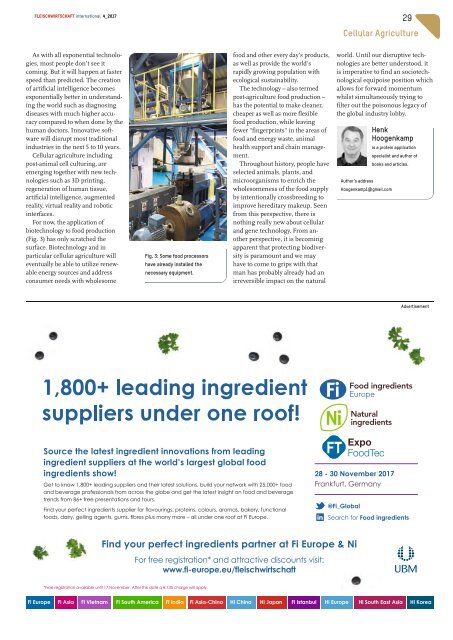FLEISCHWIRTSCHAFT international 4/2017
- No tags were found...
Create successful ePaper yourself
Turn your PDF publications into a flip-book with our unique Google optimized e-Paper software.
Fleischwirtschaft <strong>international</strong> 4_<strong>2017</strong><br />
29<br />
Cellular Agriculture<br />
As with all exponential technologies,<br />
most people don’t see it<br />
coming. Butitwill happen at faster<br />
speed than predicted. The creation<br />
of artificial intelligence becomes<br />
exponentially better in understanding<br />
the world such as diagnosing<br />
diseases with much higher accuracy<br />
compared to when done by the<br />
human doctors. Innovative software<br />
will disrupt most traditional<br />
industries in the next 5to10years.<br />
Cellular agriculture including<br />
post-animal cell culturing, are<br />
emerging together with new technologies<br />
such as 3D printing,<br />
regeneration of human tissue,<br />
artificial intelligence, augmented<br />
reality,virtual reality and robotic<br />
interfaces.<br />
Fornow,the application of<br />
biotechnology to food production<br />
(Fig. 3) has only scratched the<br />
surface. Biotechnology and in<br />
particular cellular agriculture will<br />
eventually be able to utilize renewable<br />
energy sources and address<br />
consumer needs with wholesome<br />
Fig. 3: Some food processors<br />
have already installed the<br />
necessary equipment.<br />
food and other every day’s products,<br />
as well as provide the world's<br />
rapidly growing population with<br />
ecological sustainability.<br />
The technology –also termed<br />
post-agriculture food production –<br />
has the potential to make cleaner,<br />
cheaper as well as more flexible<br />
food production, while leaving<br />
fewer "fingerprints" in the areas of<br />
food and energy waste, animal<br />
health support and chain management.<br />
Throughout history,people have<br />
selected animals, plants, and<br />
microorganisms to enrich the<br />
wholesomeness of the food supply<br />
by intentionally crossbreeding to<br />
improve hereditary makeup. Seen<br />
from this perspective, there is<br />
nothing really new about cellular<br />
and gene technology.From another<br />
perspective, it is becoming<br />
apparent that protecting biodiversity<br />
is paramount and we may<br />
have to come to grips with that<br />
man has probably already had an<br />
irreversible impact on the natural<br />
world. Until our disruptive technologies<br />
are better understood, it<br />
is imperative to find an sociotechnological<br />
equipoise position which<br />
allows for forward momentum<br />
whilst simultaneously trying to<br />
filter out the poisonous legacy of<br />
the global industry lobby.<br />
Author’s address<br />
Henk<br />
Hoogenkamp<br />
is aprotein application<br />
specialist and author of<br />
books and articles.<br />
Hoogenkamp1@gmail.com<br />
Advertisement

















